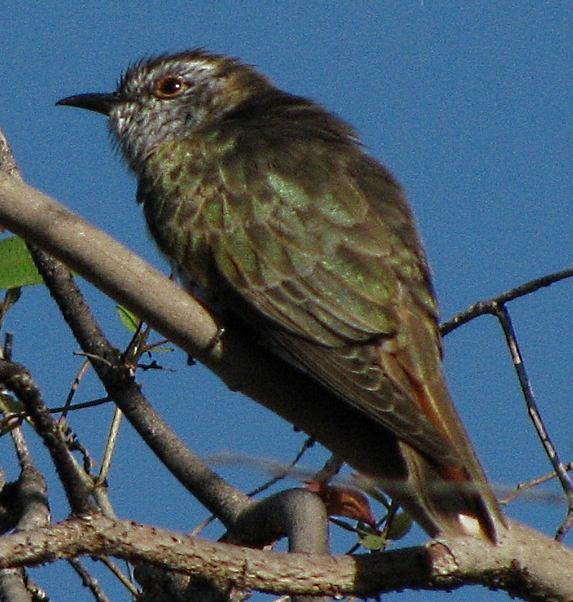This morning, a blustery wind on the heels of rain shoved me with a breathy hand as I rode the parkway to James Cook University in an open-ended search for birds. I came away with a somewhat startling 54 species that included my first sighting of a channel-billed cuckoo, a medium-large grey bird with a barred tail and a bulky yellow bill. The characteristic, descending “fear, fear, fear…” of a brush cuckoo chimed out over the parkway, and I spotted an eastern koel (a crow-sized, black cuckoo with red eyes and a pale grey bill), identifying it as the singer of a mysterious song Ive heard during the past week. Both the koel, also known as ‘rainbird,’ and the channel-bill, alias ‘stormbird,’1 complimented the morning’s cool, blustery ambience and, along with the brush cuckoo, inspired me to do a little research on Australian cuckoos.
Cuckoos are well known as nest parasites, that is, birds that lay their eggs in the nests of other species, thus leaving their young to be reared by foster parents. Of the 126 species of cuckoos found throughout the world, 13 species occur in Australia.2 All belong to the avian family Cuculidae, which is divided into three groups. The first of these is comprised of typical cuckoos, which are a half dozen slender, long-tailed cuckoos that resemble songbirds and include the brush cuckoo as well as fan-tailed, chestnut-breasted, oriental, and pallid cuckoos, plus the large, vagrant long-tailed cuckoo.3 Of these I have seen in Australia only the brush cuckoo to date, but have observed the barred and streaked long-tailed cuckoo on the North Island of New Zealand.

Little Bronze-cuckoo on Baza Island, Ross River Bush Gardens (© Magi Nams)
The second group within the cuckoo family is the bronze-cuckoos, five species which are noticeably smaller than typical cuckoos and have much shorter tails. This cuckoo cluster incudes the black-eared cuckoo as well as little, Horsfield’s, shining, and Gould’s bronze-cuckoos.4 To date, I’ve observed three members of this group, the Horsfield’s, little, and shining bronze-cuckoos.
The third group of cuckoos consists of two large species, the eastern koel, which I observed singing this morning, and the massive-beaked channel-billed cuckoo, which I also saw, in flight. Unlike other cuckoos, the young of which quickly eject their host’s eggs or offspring from the nest, the young of koels and channel-billed cuckoos rapidly outgrow their foster siblings and garner most of the food, leaving the young of the host species to starve and die.5
Many of Australia’s cuckoos are migratory, moving with the seasons to and from various parts of the country or destinations such as Papua New Guinea, Fiji, Timor, Indonesia, or the Solomon Islands. Both the eastern koel and channel-billed cuckoo spend the southern winter in Papua New Guinea or Indonesia, returning to northern and eastern regions of Australia to breed in spring and summer.6
The koel, whose song I first detected last week, although I hadn’t yet identified the singer, parasitizes the nests of some of the parkway birds most familiar to me – magpie-larks, blue-faced honeyeaters, figbirds, friarbirds, and olive-backed orioles. The channel-billed cuckoo, which is by far the largest Australian cuckoo, lays its eggs in the nests of correspondingly larger hosts such as Australian magpies, Torresian crows, and pied currawongs, all of which I have observed; in particular, the magpies, which I see nearly every day. The typical cuckoos and bronze-cuckoos parasitize nests of smaller songbirds such as fairy-wrens, flycatchers, and honeyeaters – again, birds which I consider to be more than mere acquaintances.6 From now on during my birding excursions, for the remainder of my time in this country, I’ll wonder in whose nests cuckoos have laid their eggs, and which unfortunate songbird or corvid parents are busting themselves providing food for loudly-begging, unwanted foster offspring that have killed their own.
Today’s birds: laughing kookaburras, blue-faced honeyeaters, peaceful doves, house sparrows, leaden flycatcher, rainbow bee-eaters, mynas, Australian white ibises, magpie-larks, white-throated honeyeaters, masked lapwings, great bowerbirds, brown honeyeaters, white-gaped honeyeaters, rainbow lorikeets, olive-backed orioles, yellow honeyeaters, white-bellied cuckoo-shrikes, helmeted friarbird, rock doves, yellow-throated miners, black kite, sulphur-crested cockatoos, mangrove gerygone, blue-winged kookaburras, spangled drongoes, figbirds, eastern koels, brush cuckoo, welcome swallows, *channel-billed cuckoo, Australian raven, black-faced cuckoo-shrikes, Torresian crow, straw-necked ibis, bush stone-curlews, pale-headed rosella, Australian magpie, crested pigeon, willie wagtail, red-backed fairy-wren, little egret, magpie geese, intermediate egrets, anhingas, little pied cormorant, Australian pelicans, Pacific black ducks, little black cormorant, white-breasted woodswallows, nutmeg mannikins, noisy friarbird, Australian brush-turkeys, red-tailed black-cockatoos, scaly-breasted lorikeets. (*Denotes lifelist sighting)
Reference:
1. Graham Pizzey and Frank Knight. The Field Guide to the Birds of Australia. 1997. Angus & Robertson, Sydney, p. 298; 2. Ibid, p. 534; 3. Ibid, pp. 534, 292-295; 4. Ibid, pp. 534, 296-297; 5. Ibid, p. 534; 6. Ibid, pp. 292-298.


